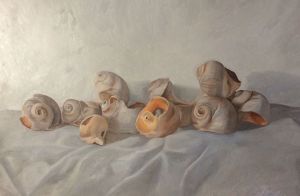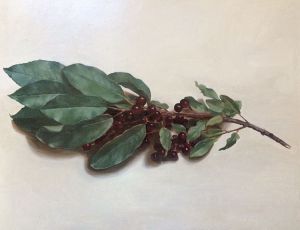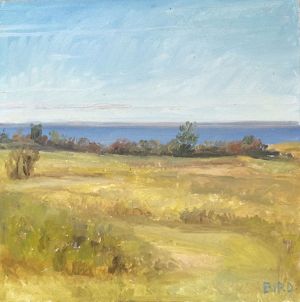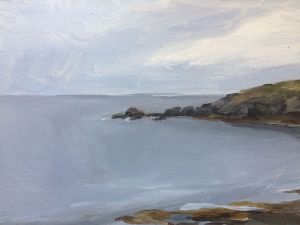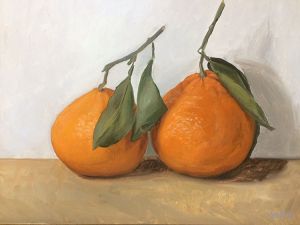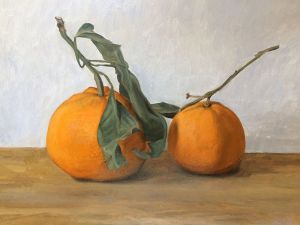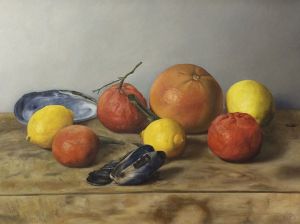“These are my winter, off-season paintings, “ said Sarah Bird about her recent still lifes and landscapes available through Jessie Edwards Studio. Bird’s artistic impulses are tied to the seasons, and, as she explains, they reflect her reactions to a particular time of year.
In winter, she turns inward to concentrate on capturing the essence of whatever attracts her eye. For example, in her series of mandarin orange still lifes, she catches the tactile sense of the rough and shiny skin of the oranges that hints at the succulent sections inside. We sense that the skin is firm but easy to peel, its texture in contrast to the fragile, papery leaves that curl around the fruit.
This three-dimensional, sculptural quality is also seen in “Choke Cherry.” Small translucent purple-red cherries glisten with rich color and ripeness. Clustered on a branch, the cherries are distinct in shape and firmness and are surrounded by smooth dark green leaves with finely serrated edges.
Bird calls still lifes a “poetic genre” and takes great care to create “altaresque” settings for her subjects. Even though her subjects are taken from nature — fruit, shells, flowers — they are meant to be seen not as if they are in an unplanned, natural setting, but in one that pays homage to the object’s essential presence and that allows us to “see the thing itself,” she explained. “Moonshells” is a good example. The delicate moonshells — gathered in October from Dorie’s Cove — are arranged carefully on a textured white cloth. The light is directed from the left side in order to draw attention to the whorls of the smooth, rounded shells, their jagged edges, and their warm yellow and orange interior colors and contours.
“Midwinter” brings the fruits of the orchard and the sea together with opened mussel shells strewn among lemons, grapefruit, and oranges.
Bird’s New England childhood growing up in Concord, Massachusetts, home of the Transcendentalists, and the influence of the Hudson River School of Painting instilled in her a reverence for the untouched natural beauty of the American landscape. This sensibility is seen not only in her emphasis on capturing the essence of a subject in her still lifes but also in her landscapes. “Hodge Property,” begun during an October visit to Block Island, is a view across warm, golden fields and clear blue water, with the mainland a long grey streak across the horizon. A pale blue sky is flocked with wispy clouds. “Island View” is a meditation in subtle blues and grey. The island is Manana Island in Maine, with its rocky coast curving into the flat grey-blue water in the center of the painting and linking land, sea, and sky.

